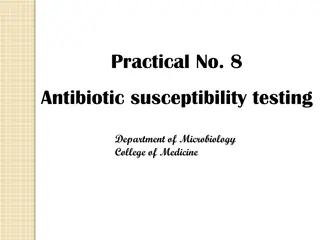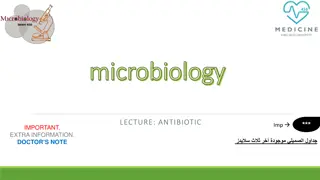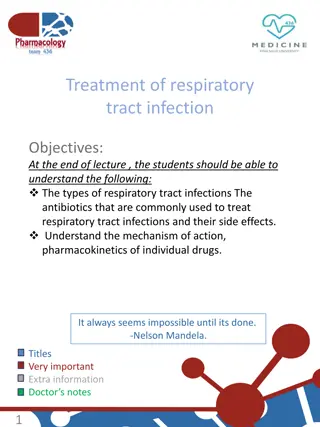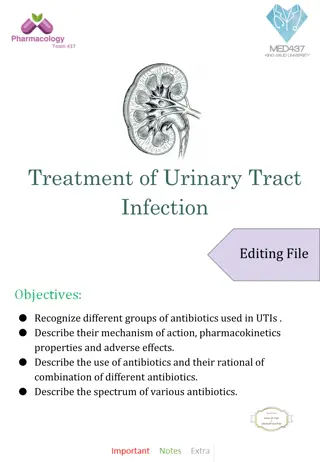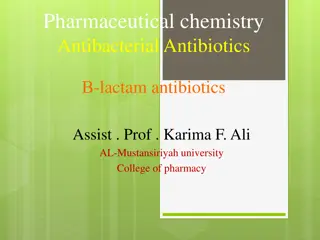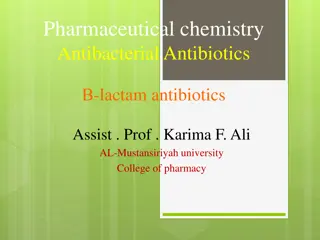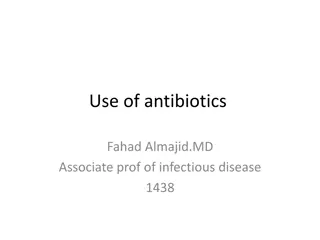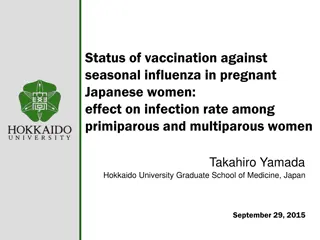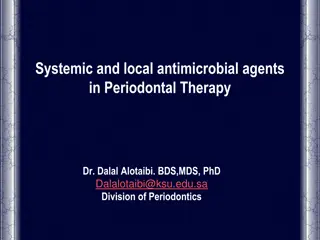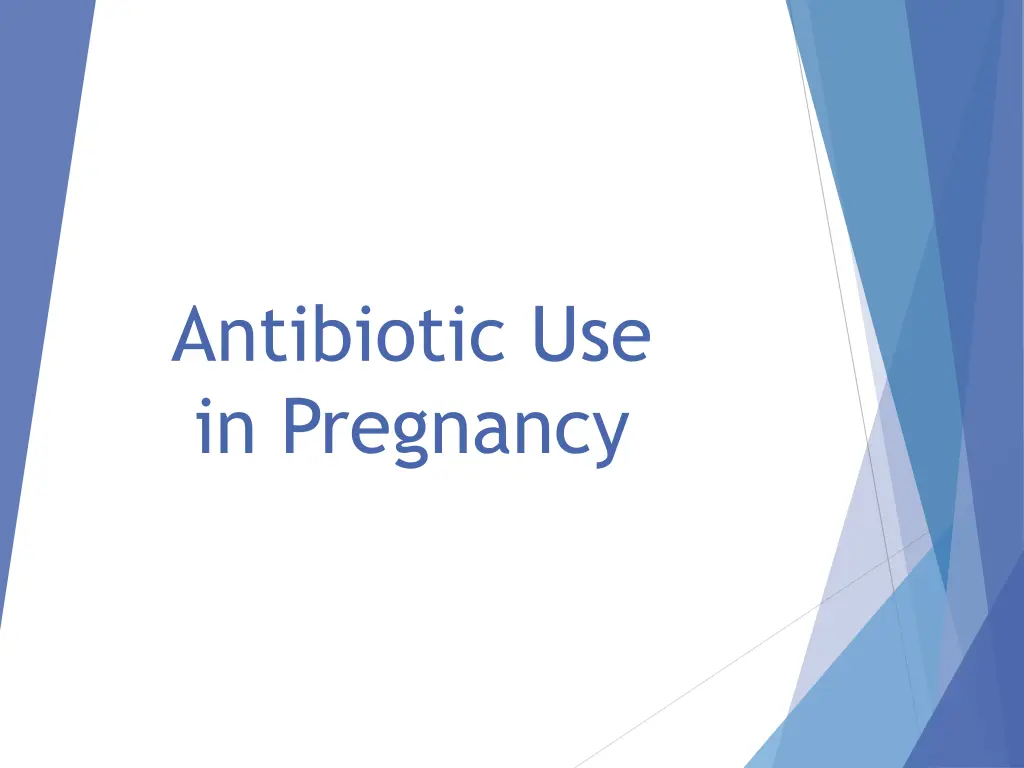
Antibiotic Use in Pregnancy Categories and Medication Lists
Understand the FDA's Pregnancy Categories for medication safety during pregnancy, including details on categories A to X. Explore various antibiotics like Penicillins, Cephalosporins, Carbapenems, and other Cell Wall Inhibitors commonly used during pregnancy with their associated risks and benefits.
Download Presentation

Please find below an Image/Link to download the presentation.
The content on the website is provided AS IS for your information and personal use only. It may not be sold, licensed, or shared on other websites without obtaining consent from the author. If you encounter any issues during the download, it is possible that the publisher has removed the file from their server.
You are allowed to download the files provided on this website for personal or commercial use, subject to the condition that they are used lawfully. All files are the property of their respective owners.
The content on the website is provided AS IS for your information and personal use only. It may not be sold, licensed, or shared on other websites without obtaining consent from the author.
E N D
Presentation Transcript
Antibiotic Use in Pregnancy
The Food and Drug Administration (FDA)'s list of Pharmaceutical Pregnancy Categories helps medical providers (and their patients) know the prenatal safety of medications. The categories are A, B, C, D, and X. To break it down, here is what the different categories mean. Category A: Shown to be safe for pregnant people Category B: Animal studies did not show risk to the fetus; no adequate human studies Category C: Animal studies showed adverse effects on the fetus or no animal or human studies Category D: Animal studies showed increased risk to the fetus, but the benefits may outweigh the risks Category X: Animal studies show clear risk and no benefits.
Penicillins Penicillin G Aqueous penicillin G Procaine penicillin G Benzathine penicillin G Penicillin V Strep. pyogenes (Grp.A)** Step. agalactiae (Grp.B)** C. perfringens(Bacilli)** Hypersensitivity reaction Hemolytic anemia Penicillin Above + Gram-negative: E. faecalis** E. Coli** Ampicillin Amoxicillin Aminopenicillins Above Methicillin Nafcillin Oxacillin Cloxacillin Dicloxacillin Above + Penicillinase- resistant-penicillins PCNase-producingStaph. aureus Above + Interstitial nephritis Carbenicillin Ticarcillin Piperacillin Above + Antipseudomonal penicillins Abo Pseudomonas aeruginosa**
Cephalosporins Staph. aureus** Staph. epidermidis** Some Gram- negatives: E. Coli Klebsiella Allergic reaction Coombs-positive anemia (3%) Cefazolin Cephalexin 1st generation Cefoxitin Cefaclor Cefuroxime Allergic Reaction ETOH Disulfiram reaction Above + Gram-negative 2nd generation Ceftriaxone Cefotaxime Ceftazidime Cefepime (4th generation) Above + Gram-negative Pseudomonas Allergic Reaction ETOH Disulfiram reaction 3rd generation
Carbapenems Imipenem (+ cilastatin) Meropenem Doripenem Ertapenem
Other Cell Wall Inhibitors Vancomycin (bacteric idal: disrupts peptioglycan cross- linkage) Vancomycin Red man syndrome Nephrotoxicity Ototoxicity MRSA** PCN/Ceph allegies** S. aureus S. epidermidis Beta-lactamase Inhibitors (bactericidal: blocking cross linking) Carbapenems Clavulanic Acid Sulbactam Tazobactam Hypersensitivity Reaction Hemolytic anemia S aureus** S epidermis** E.Coli** Klebsiella** Imipenem (+ cilastatin) Meropenem Doripenem Ertapenem Aztreonam Broadest activity of any antibiotic (except MRSA, Mycoplasma) Aztreonam Gram-negative rods Aerobes Hospital-acquired infections Polymyxins Polymyxin B Polymyxin E Topical Gram- negative infections Bacitracin Bacitracin Topical Gram- positive infections
Fluoroquinolones Fluoroquinolones (bactericidal: inhibit DNA gyrase enzyme, inhibiting DNA synthesis) 1st generation Nalidixic acid Steptococcus Mycoplasma Aerobic Gram + Phototoxicity Achilles tendon rupture Impaired fracture healing as above 2nd generation Ciprofloxacin Norfloxacin Enoxacin Ofloxacin Levofloxacin Gatifloxacin As Above +Pseudomonas 3rd generation As above + Gram- positives As above + Gram- positives + anaerobes as above 4th generation Moxifloxacin Gemifloxacin as above
Glycopeptides and Lipoglycopeptides Vancomycin Telavancin Oritavancin Dalbavancin
Classification (depending on the methods of obtaining and the number of carbon atoms in the macrocyclic lactone ring, which is their structural basis): 14- 15- ( ) 16- Natural Spiramycin (Rovamycin) Josamycin (Vilprofen) Midekamycin (Macropen) erythromycin, oleandomycin) Synthetic Roxithromycin (Rulid) Clarithromycin (Clacid) Dirithromycin Telithromycin Flurithromycin Azithromycin (Sumamed) Myocamycin Rokitamycin Similar in mechanism of action to macrolide antibiotics are ketolides (telithromycin), which, unlike macrolides, are able to overcome some resistance mechanisms of Gr(+) bacteria.
Anti-50S ribosomal subunit Streptococcus H. influenzae Mycoplamsa pneumonia Macrolides (bacteriostatic: reversibly binds 50S) Erythromycin Azithromycin Clarithromycin Coumadin Interaction (cytochrome P450) H influenzae Bacterial Meningitis Brain absces Chloramphenicol (bacteriostatic) Aplastic Anemia Gray Baby Syndrome Chloramphenicol Bacteroides fragilis S aureus Coagulase-negative Staph & Strep Excellent Bone Penetration Lincosamide (bacteriostatic: inhibits peptidyl transferase by interfering with amino acyl-tRNA complex) Pseudomembranous colitis Hypersensitivity Reaction Clindamycin Linezolid (variable) Resistant Gram- positives Linezolid VRE Quinupristin Dalfopristin Streptogramins GAS and S. aureus skin infections
Tetracyclines Classification: Biosynthetic - tetracycline, oxytetracycline. Semi-synthetic - methacycline, doxycycline (vibramycin) Combined - oletetrin, ericycline
Aminoglycosides Gentamicin Neomycin Amikacin Tobramycin Streptomycin Aerobic Gram- negatives Enterobacteriaceae Nephrotoxicity Ototoxicit (bactericidal: irreversible binding to 30S) Pseudomonas
Other DNA Inhibitors Seizures Metronidazole(bacteridic al: metabolic biproducts disrupt DNA) Metronidazole (Flagyl) Crebelar dysfunction ETOH disulfram reaction Anaerobics RNA Synthesis Inhibitors Body fluid discoloration Hepatoxicity (with INH) Rifampin(bactericidal: inhibits RNA transcription by inhibiting RNA polymerase) Staphylococcus Mycobacterium (TB) Rifampin Mycolic Acids Synthesis Inhibitors TB Isoniazid Isoniazidz Latent TB Folic acid Synthesis Inhibitors Trimethoprim/Sulf amethoxazole (SMX) Sulfisoxazole Sulfadiazine Trimethoprim/ Sulfonamides (bacteriostatic: inhibition with PABA) UTI organisms Proteus Enterobacter Thrombocytopenia Avoid in third trimester of pregnancy Malaria T. gondii Pyrimethamine Pyrimethamine


